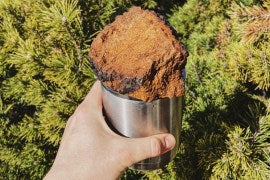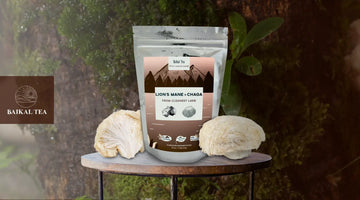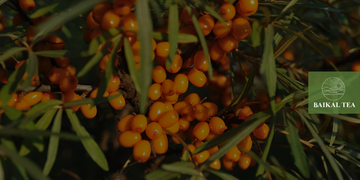Introduction

Chaga tea, derived from the Chaga mushroom, has gained popularity in recent years due to its potential health benefits. But what does Chaga tea actually taste like? In this comprehensive guide, we will delve into the flavors of Chaga tea and explore its unique taste profile. We will also discuss the factors that influence its taste, brewing techniques, and popular flavor combinations.
Unveiling the Taste Profile of Chaga Tea

Chaga tea has a distinct taste that sets it apart from other mushroom-based beverages. It is often described as earthy, with subtle hints of coffee, vanilla, and nuttiness. The flavor is rich and full-bodied, making it a comforting and satisfying drink. However, it's important to note that the taste of Chaga tea can vary depending on several factors, such as the brewing method and the quality of the Chaga used.
The Influence of Brewing Techniques
The brewing method can greatly impact the taste of Chaga tea. If steeped for a shorter duration, the tea will have a milder flavor, while a longer steeping time can result in a stronger, more bitter taste. It is recommended to experiment with different brewing times to find the perfect balance that suits your palate.
The Role of Chaga Species

The taste of Chaga tea can also be influenced by the species of tree on which the Chaga mushroom grows. Chaga harvested from birch trees, especially white or golden Birch, tends to have a milder and more pleasant taste. On the other hand, Chaga obtained from other tree species may have a more bitter or unpleasant flavor. It is essential to ensure that the Chaga used for brewing is sourced from the correct species of tree to enjoy the optimal taste.
Flavor Enhancements and Pairings
While Chaga tea has a unique taste on its own, there are various ways to enhance its flavor and create delightful combinations. Adding ingredients like Chai spice, cinnamon, turmeric, or honey can complement the taste of Chaga tea and add depth and complexity to the flavor profile. Additionally, pairing Chaga tea with foods that complement its earthy notes, such as whole-grain bread, cheese, or roasted vegetables, can create a well-rounded and enjoyable culinary experience.
The Origins of Chaga and its Cultural SignificanceBefore we further explore the taste of Chaga tea, let's delve into the origins and cultural significance of this remarkable fungus.
Chaga Mushroom: Nature's Medicinal Marvel

The Chaga mushroom, scientifically known as Inonotus obliquus, is predominantly found in the Northern Hemisphere, thriving in cold climates such as Siberia, Northern Canada, Alaska, and certain parts of the continental United States. It predominantly grows on birch trees, absorbing and transforming the tree's compounds into beneficial substances.
The external appearance of Chaga is distinct, resembling a burnt piece of charcoal with a deeply cracked exterior. However, the inside of the mushroom is soft and cork-like, boasting a rich golden-brown color. It is essential to harvest Chaga from mature trees and properly dry and prepare it to preserve its health benefits.
Chaga in Traditional Practices
Chaga has a long history of use in various cultures and traditional practices. Indigenous Siberian tribes and North American cultures, such as the Inuit, have been incorporating Chaga into their traditional medicine for centuries. In European folklore, particularly in Russia and Scandinavia, Chaga has been revered as a powerful health tonic and an integral part of folk medicine.
The global recognition of Chaga has grown as modern medicine explores its potential health benefits. Today, people from all walks of life are embracing Chaga tea for its potential immune-boosting properties and antioxidant content.
Health Benefits of Chaga TeaBeyond its unique taste, Chaga tea is celebrated for its potential health benefits. Let's explore some of the reasons why Chaga tea has gained popularity as a wellness beverage.
Immune-Boosting Properties
Chaga tea is rich in antioxidants and beta-glucans, compounds known for their immune-enhancing properties. A strong immune system is crucial for overall health and well-being, and Chaga tea may provide a natural boost to the immune system. Studies have shown that the compounds found in Chaga can stimulate the production of immune cells and support the body's defense against infections and diseases.
Potential Anti-Cancer Effects
Chaga has also been studied for its potential anti-cancer properties. It is believed that the antioxidants and anti-inflammatory compounds present in Chaga may inhibit the growth of cancer cells. While more research is needed in this area, the preliminary findings are promising and highlight the potential of Chaga as a complementary therapy in cancer treatment.
Other Potential Health Benefits
In addition to immune support and potential anti-cancer effects, Chaga tea is believed to have other health benefits. It may help regulate blood sugar levels, support digestive health, and promote overall vitality. However, it's important to note that further research is needed to fully understand the extent of these benefits and their mechanisms of action.
Brewing Chaga Tea: A Step-by-Step Guide

Now that we have explored the taste and health benefits of Chaga tea, let's dive into the art of brewing this unique beverage. Follow these simple steps to prepare a delicious cup of Chaga tea:
Step 1: Choose Your Chaga
Start by selecting high-quality Chaga mushrooms or Chaga powder. Look for products that are sourced from clean and unpolluted areas, and opt for those that have been air-dried to preserve their beneficial properties. You can choose between Chaga chunks or Chaga powder, depending on your preference.
Step 2: Prepare the Chaga
If using Chaga chunks, break them down into smaller pieces. For Chaga powder, you can skip this step. The size of the Chaga pieces can impact the intensity of the flavor, so adjust accordingly to your taste preference.
Step 3: Brew the Chaga
Add about one tablespoon of Chaga mushrooms or Chaga powder to a pot. Pour in about four cups of water and bring the mixture to a boil. Once it reaches a boil, reduce the heat and let it simmer for at least an hour. Remember that the longer you brew, the stronger the flavor will be, so adjust the brewing time to your liking.
Step 4: Strain and Serve
After simmering, strain the tea if you used Chaga chunks. If you used Chaga powder, there's no need to strain. Pour the brewed Chaga tea into your cup and enjoy its earthy and nuanced flavors.
Experimenting with Chaga Tea FlavorsWhile Chaga tea has a unique and pleasing taste on its own, there are endless opportunities for flavor experimentation. Here are some popular flavor combinations and recipes to try:
1. Chaga Tea with Honey and Lemon

This classic combination adds a touch of sweetness and a refreshing citrus twist to Chaga tea. Brew your Chaga tea as usual and add a teaspoon of honey to taste. Squeeze in the juice of half a lemon, stir well, and savor the delightful flavors.
2. Chaga Chai

For a spicier take on Chaga tea, create a Chaga chai blend. Add traditional chai spices like cinnamon, cloves, cardamom, and ginger to your brewing Chaga tea. Let the brew simmer for an additional 10-15 minutes to infuse the flavors. Strain the tea, add a splash of milk if desired, sweeten to taste, and indulge in the aromatic and comforting flavors of Chaga chai.
3. Chaga London Fog

Inspired by the popular London Fog tea, this recipe combines Chaga tea with Earl Grey tea, milk, and a hint of vanilla. Brew Chaga tea and Earl Grey tea separately, then combine them in equal parts. Add a splash of milk and a drizzle of vanilla syrup or a vanilla bean pod for a creamy and fragrant twist on Chaga tea.
4. Or just good old Baikal Chaga Tea!

But if you're the classic type, you can never go wrong with just steeping a bag of Baikal's Chaga Tea. Just pop in a sachet into a hot water bath, leave it for 8 minutes, before you can enjoy a cuppa! The Siberian origins of this tea brew is what adds a depth of flavor, with all the authentic goodness to go along with it!
Conclusion
Chaga tea offers a unique and complex flavor profile that sets it apart from other mushroom-based beverages. Its earthy taste, reminiscent of coffee and vanilla, makes it a comforting and satisfying drink. Brewing techniques, Chaga species, and flavor enhancements all play a role in shaping the taste of Chaga tea. Experimenting with different brewing methods and flavor combinations allows you to tailor the taste of Chaga tea to your liking.
Not only does Chaga tea have a delightful taste, but it also holds potential health benefits, including immune support and possible anti-cancer effects. Incorporating Chaga tea into your daily routine can be a delicious and nutritious way to boost your well-being.
So, what does Chaga tea taste like? It's an experience that combines earthiness, subtle sweetness, and hints of coffee and vanilla. Try brewing a cup of Chaga tea today and embark on a flavorful journey that nourishes both your body and soul.





